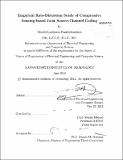Empirical rate-distortion study of compressive sensing-based joint source-channel coding
Author(s)
Rambeloarison, Muriel Lantosoa
DownloadFull printable version (4.281Mb)
Other Contributors
Massachusetts Institute of Technology. Dept. of Electrical Engineering and Computer Science.
Advisor
Muriel Médard.
Terms of use
Metadata
Show full item recordAbstract
In this thesis, we present an empirical rate-distortion study of a communication scheme that uses compressive sensing (CS) as joint source-channel coding. We investigate the rate-distortion behavior of both point-to-point and distributed cases. First, we propose an efficient algorithm to find the 4-norm regularization parameter that is required by the Least Absolute Shrinkage and Selection Operator (LASSO) which we use as a CS decoder. We then show that, for a point-to-point channel, the rate-distortion follows two distinct regimes: the first one corresponds to an almost constant distortion, and the second one to a rapid distortion degradation, as a function of rate. This constant distortion increases with both increasing channel noise level and sparsity level, but at a different gradient depending on the distortion measure. In the distributed case, we investigate the rate-distortion behavior when sources have temporal and spatial dependencies. We show that, taking advantage of both spatial and temporal correlations over merely considering the temporal correlation between the signals allows us to achieve an average of a factor of approximately 2.5 times improvement in the rate-distortion behavior of the joint source-channel coding scheme.
Description
Thesis (M. Eng.)--Massachusetts Institute of Technology, Dept. of Electrical Engineering and Computer Science, 2012. Cataloged from PDF version of thesis. Includes bibliographical references (p. 45-46).
Date issued
2012Department
Massachusetts Institute of Technology. Department of Electrical Engineering and Computer SciencePublisher
Massachusetts Institute of Technology
Keywords
Electrical Engineering and Computer Science.